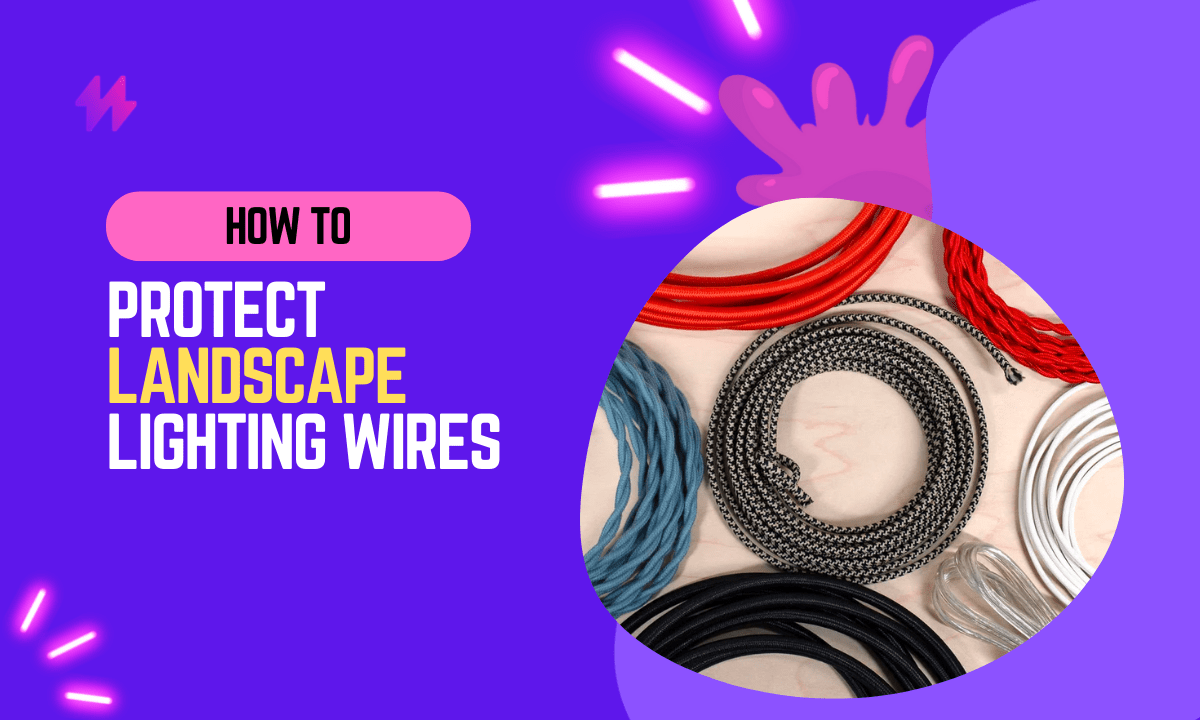How to Protect Landscape Lighting Wire

Landscape lighting can add a lot of beauty and charm to your home, and it’s a great way to make your property stand out from the rest. However, if you don’t take the proper precautions, you could run into some big problems.
In this article, we will discuss how to protect landscape lighting wires from weather damage, rodents, and other hazards. Let’s get started!
To ensure a successful lighting installation, it’s essential to adhere to safety standards when working with wiring cables and fixtures. Using protective covers and weather-resistant wiring can contribute to a resilient lighting system that enhances your landscaping and accent lighting.
How to Protect Landscape Lighting Wire from Weather Damage in Outdoor Lighting
One of the biggest threats to landscape lighting wires is weather damage. Water and sunlight can both wreak havoc on wiring, causing it to break down and become brittle over time.
To protect your landscape lighting wire from weather damage, you should:
- Use a Waterproof sealant: A waterproof sealant will help keep water out of your wiring, and it will also provide some protection from sunlight.
- Use heat shrink tubing: Heat shrink tubing is a great way to protect your landscape lighting wire from both water and sunlight. It’s easy to install, and it will give your wiring an extra layer of protection.
- Use a UV-resistant jacket: If you live in an area with a lot of sunlight, a UV-resistant jacket will help keep your landscape lighting wire from deteriorating.
You may also like to know How to hide Under Cabinet lighting wires
To ensure that your landscape wiring remains intact, consider using high-quality landscape materials designed to withstand the elements. Incorporating well-protected lighting systems with proper insulation will allow your outdoor applications, such as path lights and outdoor flood lights, to thrive in various landscapes.
Safeguard Landscape Lighting Wire from Rodent Damage
Another big threat to landscape lighting wire is rodents. Mice and rats love to chew on wiring, and they can cause a lot of damage in a short amount of time.
To protect your landscape lighting wire from rodents, you should:
Another big threat to landscape lighting wire is rodents. Mice and rats love to chew on wiring, and they can cause a lot of damage in a short amount of time. To protect your landscape lighting wire from rodents, you should use wire mesh around exposed areas, as it is an effective way to protect your investment. Additionally, using electrical tape to seal and waterproof connections ensures your low-voltage wiring remains intact, contributing to the long-term lighting usage and maintenance of your impressive landscape.
- Use Rodent-Resistant Wire: There are special types of wire that are designed to resist chewing from rodents. This type of wire is usually more expensive, but it’s worth the investment if you want to keep your wiring safe.
- Use Rodent Traps: If you have a rodent problem, setting out some traps can help catch the culprits before they have a chance to damage your wiring.
- Use a Wire Mesh: A wire mesh can also help keep rodents away from your landscape lighting wire. Just make sure that the mesh is small enough so that mice and rats can’t squeeze through.
Safeguarding Landscape Lighting Wire from Additional Hazards
In addition to weather damage and rodents, there are other hazards that can damage landscape lighting wires. These include lawnmowers, cars, and even curious children.
To protect your landscape lighting wire from these hazards, you should:
To further enhance the protections for your landscape lighting, consider burying low voltage wire underground to shield it from potential damage. Additionally, ensuring that visible wiring is properly secured and protected with landscaping staples can prevent wire breakage caused by heavy foot traffic, such as from walkways or curious children playing nearby.
- Burlap or plastic tubing: Covering your landscape lighting wire with burlap or plastic tubing can help protect it from damage. Just make sure that the tubing is secure so that it doesn’t get dislodged.
- Wire clips: Wire clips can help keep your landscape lighting wire in place, and they also provide some protection from damage.
- Electrical tape: Electrical tape can be used to cover exposed wires, and it will also help protect your wiring from damage.
In some cases, you may need to bury your landscape lighting wire. This is usually done when running wire through an area that is difficult to access.
When burying landscape lighting wire, you should:
- Use a trencher: A trencher is a tool that can be used to dig a trench for your wiring. This will make it easier to bury your wiring, and it will also help protect the wire from damage.
- Use conduit: A conduit is a type of piping that can be used to protect your wiring as it runs underground. Just make sure that the conduit is properly sealed so that water doesn’t get in.
- Use buried cable: Buried cable is specially designed to be buried underground. This type of cable is more expensive, but it’s worth the investment if you need to bury your wiring.
Protecting your landscape lighting wire is important if you want it to last for years to come. By taking some simple precautions, you can keep your wiring safe from weather damage, rodents, and other hazards. Just remember to use the appropriate type of protection for each situation, and your landscape lighting wire will be sure to stay in good condition.
However, if you do run into problems, don’t hesitate to call a professional for help.
To effectively integrate lighting into your landscape design, collaborating with professional landscapers can provide invaluable insights on optimizing low-voltage wiring. Implementing durable low-voltage landscape solutions not only enhances the aesthetics of your outdoor area but also ensures that your investment in actual lamps and light fixtures remains protected over time.
Conclusion: Ensuring the Longevity of Your Landscape Lighting Wire
In conclusion, effectively protecting landscape lighting wire is crucial for maintaining the integrity and longevity of your outdoor lighting system. Exposure to the elements, accidental damage during yard activities, and potential interference from wildlife can all compromise the functionality of your landscape lighting. To safeguard these essential components, it is imperative to utilize proper wiring techniques and protective materials from the outset. Burying the wires at a sufficient depth is one of the most effective strategies to prevent accidental damage from lawn care activities or curious animals. Ideally, wires should be buried about six inches underground and possibly encased in conduit for added protection in areas where they may be exposed to more severe environmental stressors.
Furthermore, the use of high-quality, UV-resistant, and waterproof materials for all exposed wiring and connections is essential. These materials help prevent degradation caused by sunlight and moisture, two prevalent challenges in outdoor environments. Additionally, incorporating routine inspections into your landscape maintenance schedule ensures early detection of any potential issues, such as fraying or water damage, before they lead to system failure. These inspections provide an opportunity to address minor issues promptly, thus avoiding more significant complications down the line. By taking these proactive measures, homeowners can ensure that their landscape lighting remains a reliable and attractive feature of their outdoor spaces, enhancing both the beauty and functionality of their property while minimizing the need for costly repairs and replacements over time.
How To Protect Landscape Lighting Wire | Methods for Protecting Landscape Lighting Wire
Protecting landscape lighting wire is essential for ensuring longevity and optimal performance. New landscapers should understand how to protect landscape lighting wire by using quality wiring that adheres to electrical code requirements. Installing low-voltage wiring away from high-traffic zones can prevent unintentional damage from foot traffic, pets, or tools. A well-thought-out landscape design should consider burying low-voltage wires at proper depths alongside fence lines and shrubs to shield them from environmental elements. Using protective covers can enhance weather resistance, especially during harsh seasons when low-voltage lamps are in use. Regular inspections for signs of wear and tear, such as cut wire or fraying, are vital for maintaining the integrity of the wiring. Utilizing splices and connectors properly will ensure that previous lighting systems can seamlessly integrate with new installations, avoiding potential issues with subsequent wiring marking. Ultimately, attention to detail ensures fabulous lighting will illuminate your garden without compromising safety or aesthetics.
How to Protect Landscape Lighting Wire | Using Protective Covers for Weather Resistance
Using protective covers is an essential step in maintaining the integrity of low voltage landscape lighting systems. These covers can shield your low voltage wires and electrical lines from harsh weather conditions. Choosing options that are specifically designed for outdoor use will enhance the durability of your basic wiring. Alongside using protective covers, landscaper managers should consider how to protect landscape lighting wire from potential damage caused by other outdoor elements, such as falling branches or garden equipment.
Investing in high-quality protective covers can also prevent moisture from seeping into low voltage lamps and the actual lamp/light fixture, which could lead to electrical malfunctions. Covers made from materials like heavy-duty aluminum or durable rubber hose provide excellent resistance against wear and tear. Properly covering low voltage wiring not only prevents corrosion but also extends the lifespan of your landscape lighting system, allowing homeowners to enjoy beautifully illuminated outdoor spaces for years to come.
Selecting Durable Wire Types for Longevity
Choosing the right materials for your landscape lighting wire can significantly enhance longevity. A popular option is low-voltage lighting systems, which often utilize durable copper wiring. Copper provides excellent conductivity and can withstand harsh weather conditions, making it a superior choice compared to aluminum wiring. Aluminum wiring might be lighter and less expensive, but it doesn’t offer the same durability or resistance to corrosion as copper. Knowing how to protect landscape lighting wire starts with selecting the right materials to begin with.
Understanding the characteristics of different wire types is key for ensuring the longevity of your landscape lighting. For instance, wires designed for outdoor use typically come with UV-resistant coatings, adding a layer of protection against sun damage. This aspect is crucial, especially for wiring that may be exposed while illuminating areas like pathways or gardens. Just like with christmas lights, improper wiring selection can lead to performance issues and safety concerns. By prioritizing durable wire types, homeowners can ensure that they effectively protect their investment and maintain the aesthetic appeal of their outdoor spaces.
Best Practices for Landscape Lighting Wire Installation
Proper installation of landscape lighting wire is crucial for maintaining its longevity and functionality. Knowing how to protect landscape lighting wire begins with ensuring the correct burial depth to avoid damage from surface activity or environmental factors. Placing the wiring too shallow increases the chances of wear, while deeper installations can shield it from physical disturbances. Wiring that doesn’t have secure splices and connectors may lead to electrical failures, creating a need for regular inspections and potential repairs. By following these guidelines, homeowners can effectively protect their landscape lighting systems and enjoy enhanced durability and performance.
Proper Burial Depth to Avoid Damage
Choosing the correct burial depth for landscape lighting wire is crucial to ensure its longevity and functionality. Setting the wiring at least 6 to 12 inches below the surface protects it from physical damage, such as from lawn equipment or foot traffic. This depth also helps shield the wire from temperature fluctuations that can affect its performance. Understanding how to protect landscape lighting wire through proper installation techniques is essential for maximizing its life span.
Wiring that is not buried deeply enough is more susceptible to wear and tear. Shallowly buried wires may become exposed over time due to soil erosion or landscaping activities. This increases the risk of accidental damage, which could lead to costly repairs. Knowing how to protect landscape lighting wire includes taking the time to ensure the proper burial depth, preventing potential hazards and maintaining a safe, effective landscape lighting system.
Using Splices and Connectors Safely
Properly utilizing splices and connectors is crucial for maintaining the integrity of your landscape lighting system. Wiring doesn’t just connect fixtures; it also serves as a lifeline for the entire installation. Ensuring that splices and connectors are weatherproof and securely fastened can significantly reduce the risk of short circuits or power interruptions. This is an essential part of how to protect landscape lighting wire from the elements and other potential hazards.
Selecting the right type of splice or connector also plays a vital role in preserving the longevity of your landscape lighting. Low-quality connectors can corrode over time, leading to inefficient performance or failure of the lighting system. By choosing high-quality materials, you enhance the overall durability of your installation. Understanding how to protect landscape lighting wire includes recognizing the importance of reliable connectors in preventing future issues.
Tips for Regular Maintenance of Landscape Lighting Wire
Regular maintenance of landscape lighting wire is crucial for ensuring longevity and optimal performance. One effective method for maintenance is inspecting the wire for signs of wear and tear regularly. Look for any fraying, cracking, or discoloration that could indicate damage. Understanding how to protect landscape lighting wire involves not only using durable materials and protective covers but also staying vigilant about potential issues that may arise over time. Implementing cleaning techniques, such as gently removing debris from connections and fixtures, helps enhance performance and prolong the life of the wire. Taking these steps ensures your landscape lighting remains safe and effective throughout the seasons.
Inspecting for Signs of Wear and Tear
Regular inspections are crucial for maintaining the integrity of landscape lighting wire. Over time, exposure to weather elements can lead to cracks or fraying in the insulation. This damage can expose the wire, creating safety hazards. Knowing how to protect landscape lighting wire involves understanding the signs of wear and tear. Look for discoloration, brittleness, or any visible breaks in the wire. Addressing these issues promptly can prevent more significant problems down the line.
Checking for wear is not just about visual inspections; feel along the wire for any irregularities. Changes in texture, such as rough spots or bulges, can indicate trouble. It’s essential to maintain a consistent schedule for these inspections, especially after severe weather. Familiarity with how to protect landscape lighting wire will help in identifying potential risks early. Taking action when you notice signs of deterioration can save time and money in the long run.
Cleaning Techniques to Enhance Performance
Regular cleaning of landscape lighting fixtures is essential for optimal performance. Dust, dirt, and debris can accumulate over time, obstructing light output and reducing the overall aesthetic effect. Utilizing a soft cloth or a non-abrasive sponge can help maintain the clarity of lenses and reflectors. Keeping fixtures clean ensures that your landscape lighting remains effective, enhancing curb appeal while protecting the wire from corrosion or damage caused by moisture and grime.
Understanding how to protect landscape lighting wire extends beyond just installation practices. Routine maintenance, including cleaning the wiring and connections, can significantly prolong the lifespan of your system. Inspecting for any signs of oxidation or wear during cleaning sessions can help identify potential issues early. Regularly removing trapped leaves or debris around wiring can also prevent moisture buildup, which contributes to deterioration.
Choosing the Right Location for Landscape Lighting
Identifying safe areas for wire placement is crucial for ensuring the longevity and functionality of your landscape lighting. Properly selecting locations can help minimize risk of damage to the wires, making it an essential part of how to protect landscape lighting wire. Avoiding high traffic zones is equally important, as foot traffic or lawn maintenance equipment can inadvertently disturb or sever wires. By strategically planning the placement of your lights, you enhance both their aesthetic appeal and their durability. This attention to detail will help you effectively implement methods for protecting landscape lighting wire, keeping your outdoor spaces illuminated and safe.
Identifying Safe Areas for Wire Placement
Choosing the right locations for your landscape lighting wire is crucial for ensuring durability and functionality. Prioritize areas that are shielded from the elements, such as beneath trees or shrubs. These natural barriers can provide essential protection against extreme weather, reducing the likelihood of damage to your wires. Understanding how to protect landscape lighting wire involves careful planning to avoid areas exposed to heavy rain or excessive sunlight.
Avoid placing wires in high traffic zones, where foot traffic or lawn equipment could lead to wear and tear. Routes that are frequently traversed can increase the risk of accidental cuts or abrasions. By strategically assessing your landscape, you can identify safe areas for wire placement and enhance the longevity of your lighting system. This knowledge is key in adopting the right practices for how to protect landscape lighting wire effectively.
Avoiding High Traffic Zones
Selecting the right location for your landscape lighting wire is essential. High traffic zones present a major risk for accidental damage. To learn how to protect landscape lighting wire effectively, consider routing it around pathways, driveways, and active areas. This proactive approach diminishes the chances of wires being tripped over or subjected to heavy foot or vehicle traffic, ultimately prolonging their lifespan.
Positioning your landscape lighting wire away from busy areas not only safeguards it from potential harm but also enhances the overall aesthetics of your outdoor space. Understanding how to protect landscape lighting wire includes strategic planning during installation. Ensuring that wires are tucked away in low-traffic regions will help maintain their integrity and efficiency, allowing homeowners to enjoy beautifully lit landscapes without the worry of frequent repairs.
Enhancing Secure Grounding for Landscape Lighting
Grounding plays a crucial role in the safety and functionality of landscape lighting systems. Proper grounding helps prevent electrical shocks and ensures that the fixtures operate smoothly. Knowing how to protect landscape lighting wire involves understanding the importance of a strong grounding system. Ensure that all fixtures are connected to a grounding rod or plate, which differs by local codes and regulations. This connection not only enhances safety but also reduces the risk of damage during electrical surges or storms. Regularly checking grounding connections as part of maintenance can significantly prolong the life of your lighting system and protect your investment.
Importance of Grounding in Electrical Systems
Grounding plays a crucial role in ensuring the safety and functionality of landscape lighting systems. It helps to redirect excess electrical current safely into the ground, mitigating the risk of electric shock or fire. Understanding how to protect landscape lighting wire involves recognizing the importance of proper grounding. This not only safeguards the lighting components but also enhances the overall performance and longevity of the system.
Employing effective grounding techniques is essential in any electrical installation. For landscape lighting, it is vital to ensure that all fixtures are properly grounded to prevent electrical malfunctions. Learning how to protect landscape lighting wire includes using appropriate grounding rods and connections. This proactive approach not only complies with safety regulations but also provides peace of mind for homeowners enjoying their outdoor spaces.
Conclusion
Protecting landscape lighting wire is essential for ensuring a safe and efficient outdoor lighting system. Understanding how to protect landscape lighting wire involves implementing strategies such as using protective covers for weather resistance and selecting durable wire types that can withstand environmental elements. Regular maintenance, including inspecting for signs of wear and tear, plays a crucial role in prolonging the life of your wiring. Proper burial depth and careful placement away from high traffic areas further enhance the durability of your landscape lighting wire. Following these best practices will not only safeguard your investment but also contribute to the overall functionality of your outdoor lighting.






